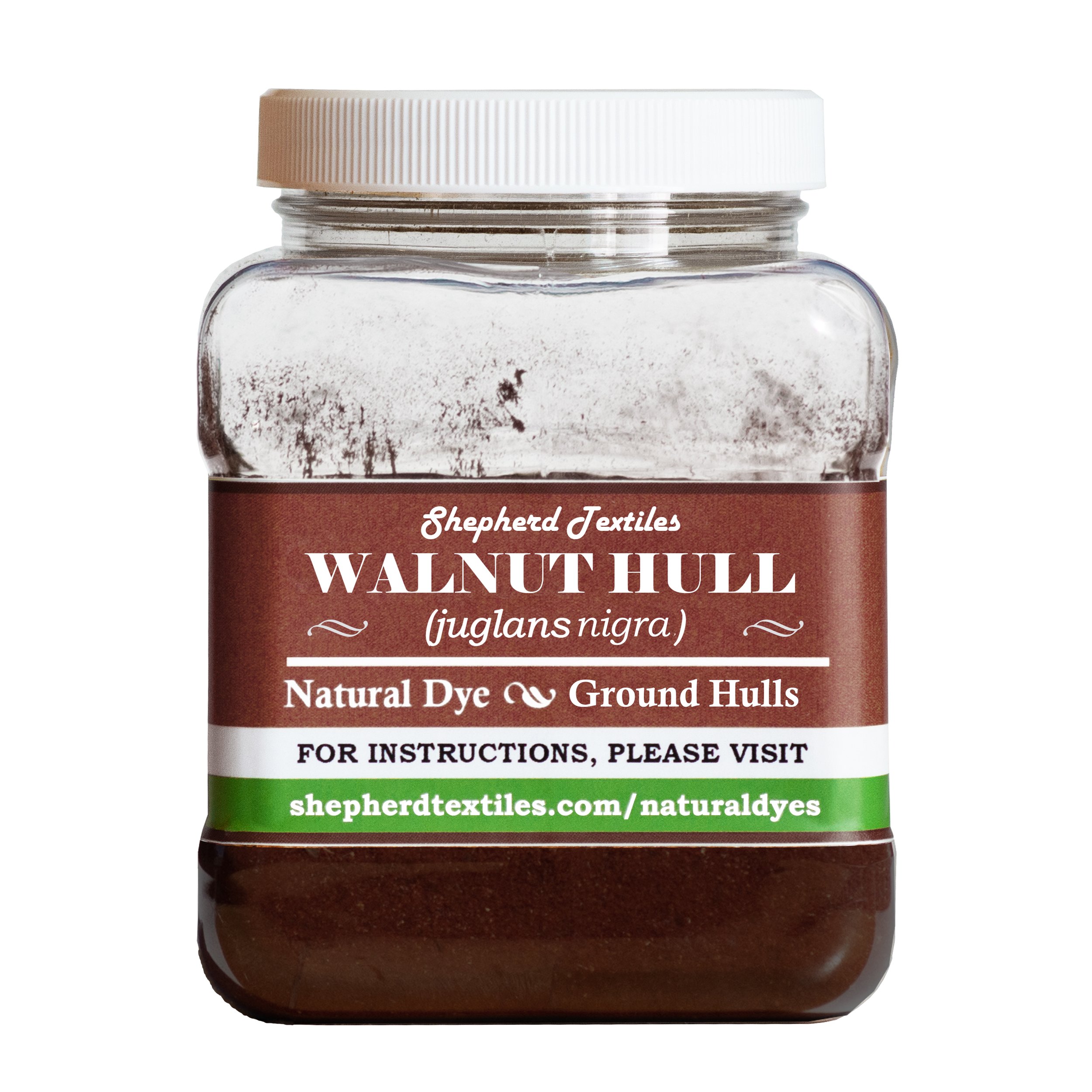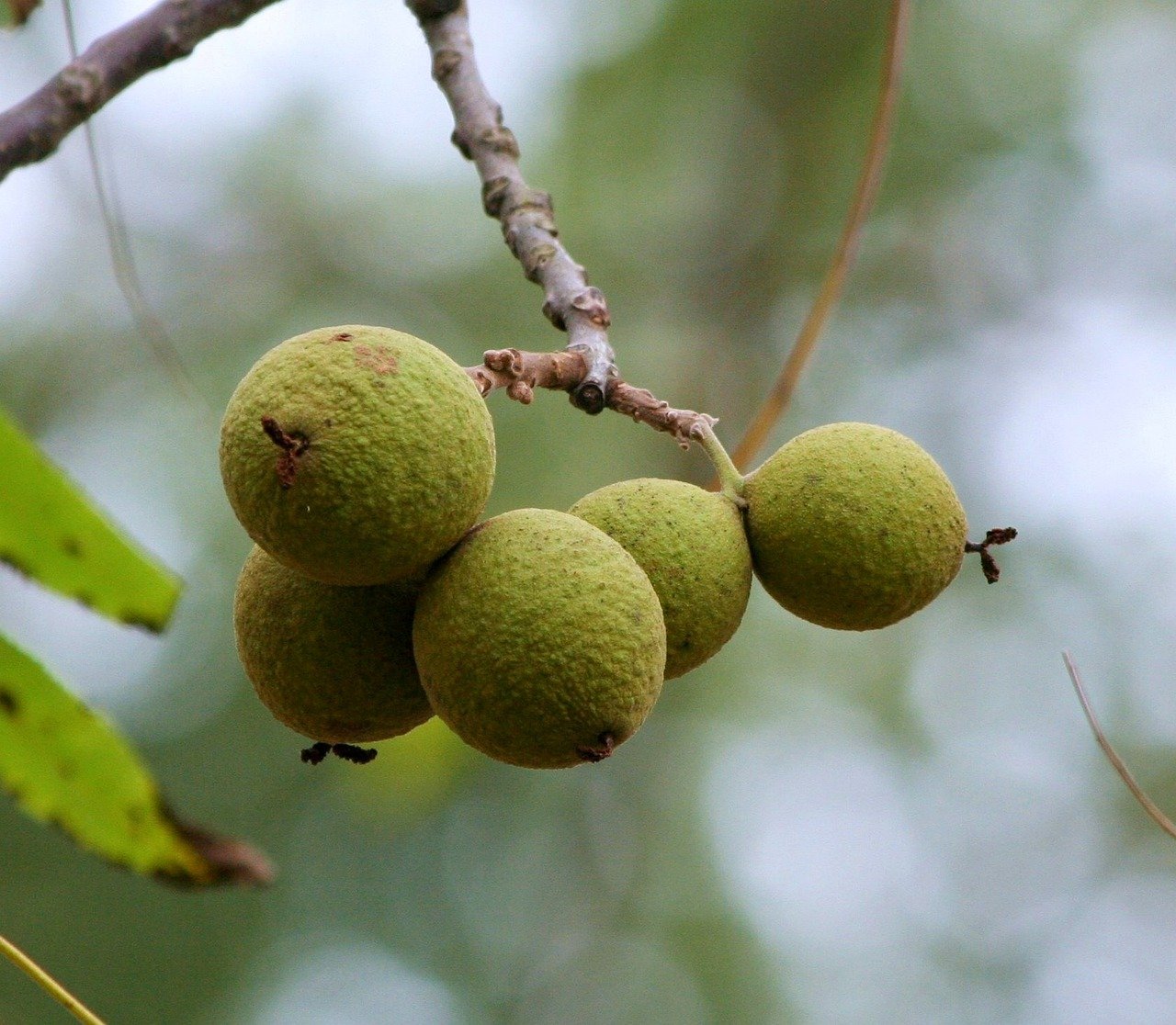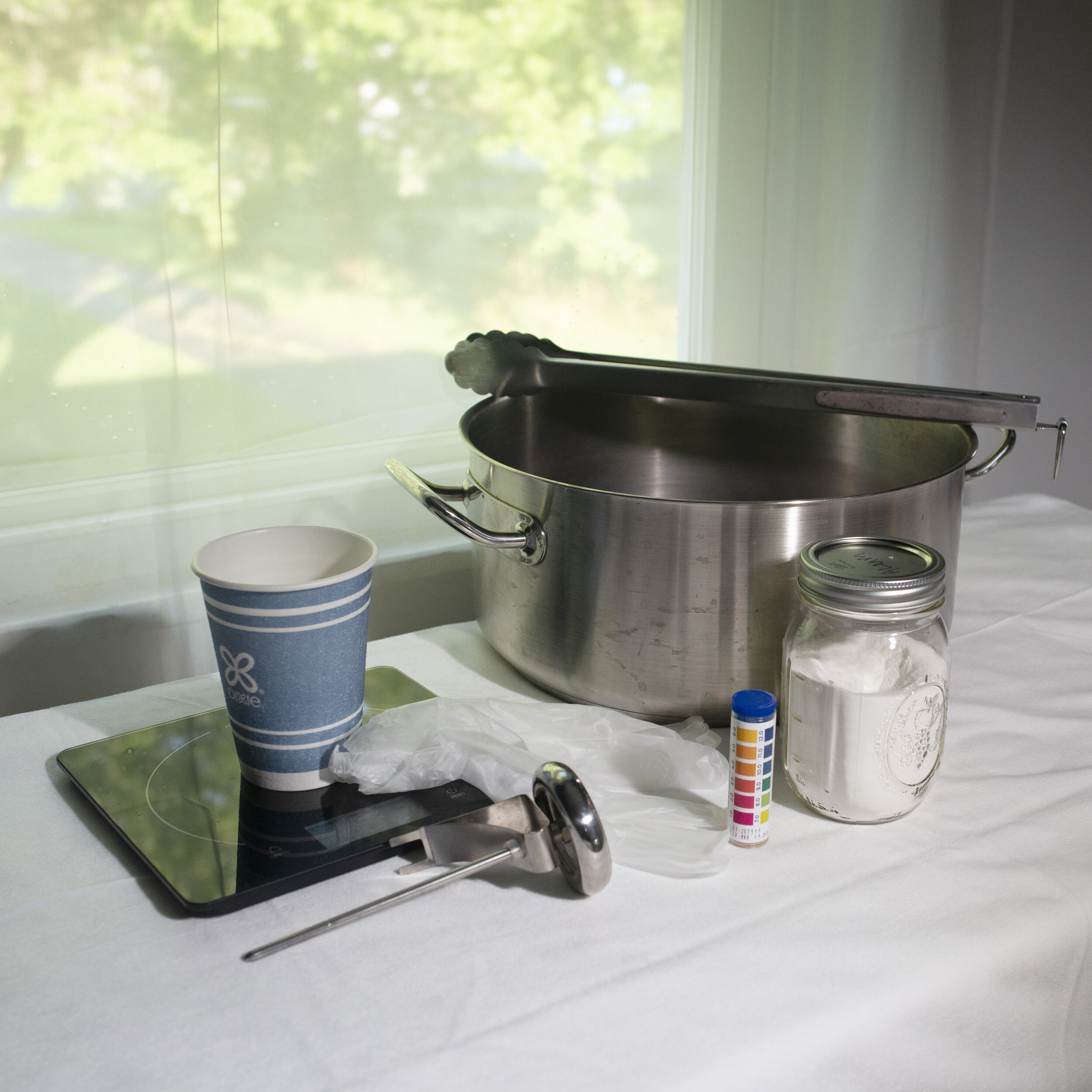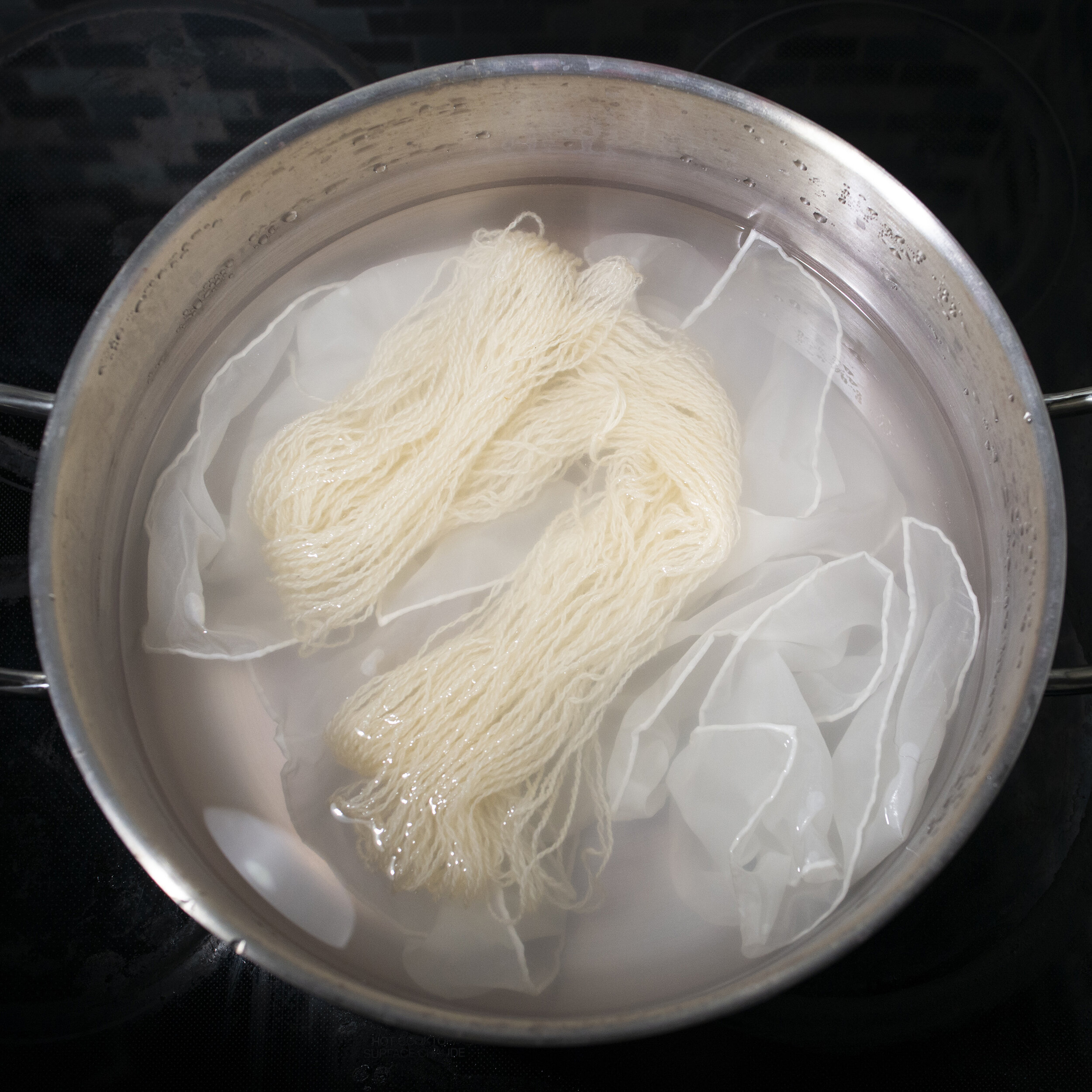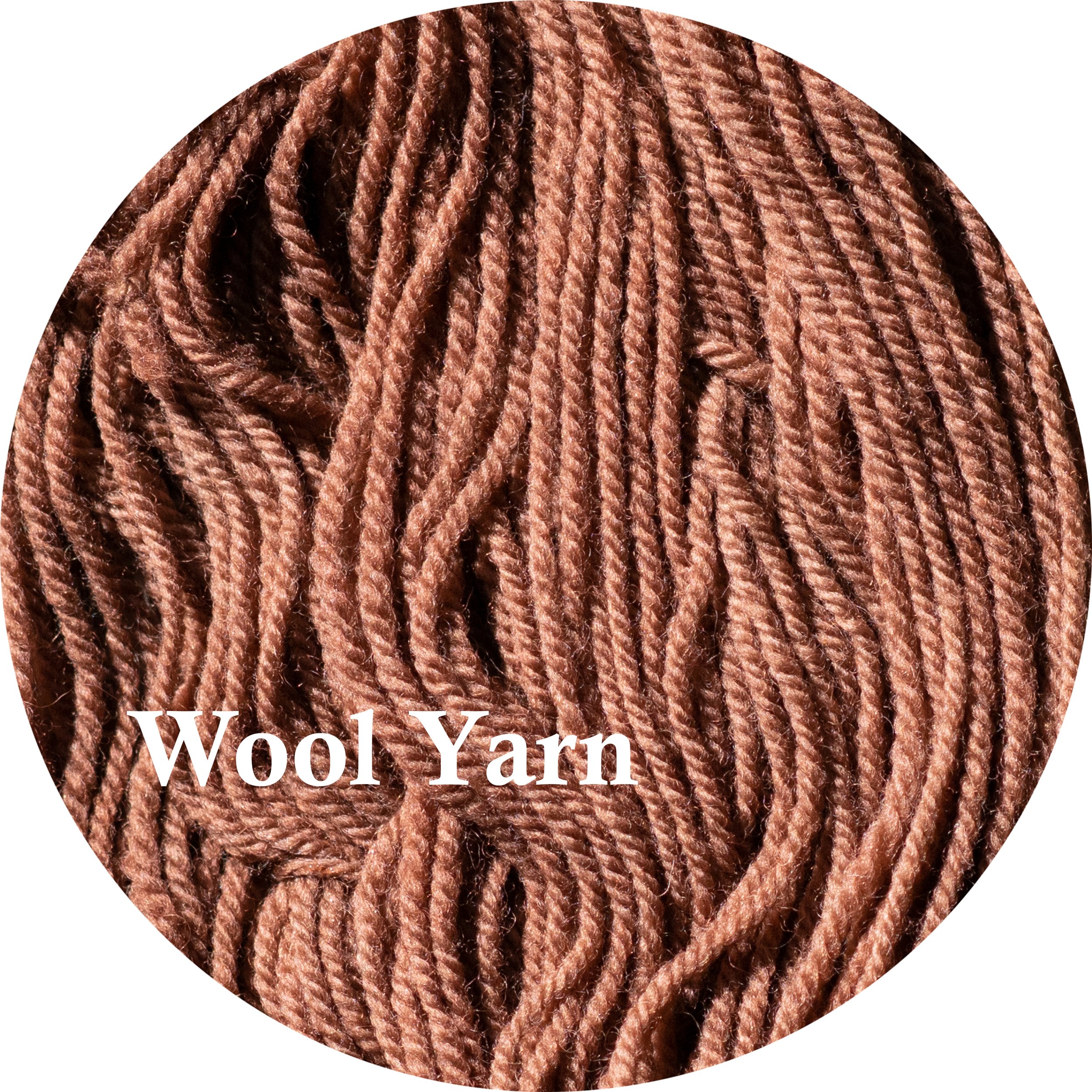
Walnut Hull
A Guide to Walnut Hull
Shepherd Textiles Walnut Hull Natural Dye is made from the ground hulls of the black walnut, juglans nigra, which contain a potent compound called juglone. Juglone evolved in the species as a defense mechanism; it is toxic to other trees, and juglone that seeps out of the roots or the fallen nuts can prevent other trees from growing within a radius of 5 or 10 feet. Juglone is also a potent natural dye, and black walnut has been used for centuries in the eastern U.S. to dye wool brown. Our walnut hulls are wild-gathered in Tennessee and ground to a coarse powder in our studio. Use them at 30% weight-of-fabric (WOF) for creamy coffee shades, or 75%-100% for darker shades of brown.
1. Background on Black Walnut
The black walnut tree, juglans nigra, is native to the eastern half of the United States. It is distributed widely, from Maryland and Pennsylvania to as far west as Kansas. The trees produce an edible fruit that is considered by many to be tastier than the more common English Walnut, although the species was never commercialized for this purpose. Black walnut trees are particularly rich in a compound called juglone, which is found in the bark, the roots, and the hulls that surround the walnut shell. Juglone is a potent herbicide that causes affected plants to wilt and eventually die (USDA 2003). This is an evolved defense mechanism, as it prevents competing trees from growing close enough to block sunlight from reaching the black walnut’s leaves.
Juglone also happens to be a potent herbal compound and natural dye that has a long history of use in the eastern U.S. The Cherokee and Chippewa used the tree both as a brown dye and as a treatment for toothache and skin infection (ibid). Later settlers used walnut hulls to dye their homespun wool brown. Indeed, black walnut gives particularly good results on wool; it produces a clear, natural brown shade without strong yellow or red hues. Black walnut trees are still common across much of the U.S., and if you have one in your yard you will find yourself with a practically infinite supply of hulls every year. Our black walnut hulls are wild-gathered in Tennessee, where they are dried in the sun before being shipped to our studio. We coarsely grind them just before packing them, so they are as fresh as a dried walnut hull can be. Use at 30% weight-of-fabric for creamy browns, or 100% for darker shades.
A Classic American Dye
2. Safety Precautions
DO NOT INGEST. This product is intended for textile dyeing, not as an herbal supplement.
Open carefully to avoid spills or creating dust.
Walnut Hull is a strong stain, especially when it gets wet. Wear gloves while handling, and take care not to let it touch countertops, clothing, or other things not meant to be stained.
Avoid eye contact. If eye contact occurs, rinse with cool water.
Not for use as a cosmetic additive; do not apply directly to skin or hair.
If a spill occurs, quickly wipe up with a paper towel or disposable rag.
Use only dye pots and utensils dedicated to dyeing. Do not use any pots, containers, spoons, tongs, thermometers, or other utensils that will be used for food preparation.
Walnut Hull powder, and all dye baths and mordant liquors made while dyeing, should be kept out of reach of children and pets. Use only with adult supervision.
Shepherd Textiles, LLC is not liable for any misuse of this product or any unintended staining of your clothing, workspace, or other property. Use only as directed.
3. Recommended Supplies
Dye pot. Use a dye pot large enough to hold all your fibers, with plenty of room for them to move around and for the liquid to circulate freely.
Metal tongs. A pair of tongs is useful for stirring and taking fabric out. Use tongs dedicated to dyeing, and not for food preparation.
Rubber gloves. Wear rubber gloves while handling mordanted/dyed fiber before it has been rinsed.
Candy thermometer. The best way to keep track of temperature is to use a candy thermometer that clips to the side of the dye pot.
Scale. Use a scale to weigh out fiber, mordant, and dyestuff.
Alum mordant. The alum usually used for mordanting is aluminum potassium sulfate, also known as potash alum. It is the same alum that you can find in a jar in the spice section at the grocery store.
4. Preparation: Mordanting with Alum
Walnut Hull is substantive on wool and silk and will dye them without the need for a metal mordant. Mordanting with alum will, however, deepen the shade and improve lightfastness. Walnut tends to give pale results on cotton, so a full treatment of tanning and mordanting and recommended. If possible, soak your fibers in water for a few hours before mordanting them, so that the mordant will penetrate deeply and evenly. Make sure to weigh the fibers first, while they are still dry.
For protein fibers (wool, silk, alpaca, etc.): Mordant at 12% WOF with alum.
Weigh out the fibers you plan to dye (while they are dry). Multiply that weight by 0.12 to get the amount of alum you will need.
Fill your dye pot with hot tap water, leaving enough room for the fiber.
Weigh out the correct amount of alum and pour it into the dye pot. Mix with a spoon or metal tongs until it has dissolved.
Gently place your fibers into the mordanting solution.
Heat mordant bath to 180F and maintain heat for 1 hour. If you don’t have a candy thermometer, you will have to estimate the temperature. At 180F, steam vapor will be rising off the water but it will not be bubbling. If your mordant bath starts to bubble, turn down the heat.
Stir every 15 or 20 minutes to make sure fibers mordant evenly. If they do not, the dye will take better in some places than others.
After an hour, remove from heat and let cool to room temperature. Once cool, you can immediately proceed to rinsing, or you can leave the fibers to steep overnight in the mordant bath. This can dramatically improve results, especially when dyeing thick or tightly woven fabrics. We often let fibers soak in the cold mordant bath for 2 or 3 nights before dyeing with madder to get the deepest, clearest scarlet colors.
When ready to rinse, put on rubber gloves and gently squeeze excess mordant solution back into the pot. Rinse fibers briefly in lukewarm water. The fiber does not need to be thoroughly washed, but any excess mordant should be rinsed out. Set aside until ready to dye. Keep out of reach of children and pets.
Dispose of mordant solution according to local guidelines.
For cellulose fibers (cotton, linen, etc.): Scour well and treat with a tannin before mordanting.
Walnut Hull gives more pale results on cotton than it does on wool. For darker results, you may wish to try a different natural brown dye like Cutch Extract or Quebracho Wood. However, to get pleasant creamy coffee colors using Walnut Hull, give cotton the full pre-treatment of tanning and mordanting.
Scour cellulose fibers well. Traditionally this is done in a highly alkaline soda ash solution. Add 2 tsp of soda ash and 1 drop of dish soap to a 5-gallon dye pot. Add cellulose fibers and heat to 180F-190F for an hour, stirring occasionally. Remove from heat, and when cool enough to handle, rinse and wring out well. Household detergents like Tide© are also alkaline (PH 11), so you can also toss the fiber in a washing machine on a high-temperature cycle with plenty of detergent. This will not clean them nearly as deeply as simmering with soda ash, but it will yield much better results than not scouring at all.
Apply a tannin to the scoured fabric. Some options include Sumac Extract at 10% weight-of-fabric or Quebracho Wood at 5% weight-of-fabric. Fill your dye pot with hot water, dissolve the tannin in the dye bath, simmer the fibers for an hour, then allow to cool. For best results, steep overnight. This process will make the cotton or linen more receptive to mordants. After steeping, remove fibers and squeeze dry.
Mordant with alum as described above for protein fibers. Some dyers like to add 1% soda ash to the mordant bath to neutralize the PH.

The Recipes
5. Recipe: Milk Chocolate
The basic recipe for Walnut Hull is to use 30% weight-of-fabric to produce a creamy milk chocolate hue on fibers mordanted with alum. Some dyers recommend adding a tablespoon or two of white vinegar to the dye bath to improve dye uptake. Increase the concentration to 100% weight-of-fabric for darker brown hues.
Fill your dye pot mostly full with warm water.
Weigh out 30% weight-of-fabric (WOF) of Walnut Hull powder. Sprinkle over the dye bath and mix well.
Heat to 180F for an hour to extract the color. Take off the heat, cover, and let cool to room temperature. For best results, steep overnight.
Filter the dyebath through a fine mesh strainer or cheesecloth to get out the small bits of walnut hull.
Add your pre-soaked and pre-mordanted fibers to the dye bath.
Heat the dyebath to 180F for wool and cotton, or 160F for silk. Maintain the heat for 2 hours, stirring occasionally to make sure all the fibers dye evenly. After 2 hours minutes, take off the heat and allow to cool to room temperature.
When cool, remove the fibers and rinse briefly in lukewarm water. You can either proceed immediately to rinsing with detergent, or hang the fabric up to dry first to help the color set. Make sure to hang it up in the shade somewhere where dripping dye will cause no damage. Direct sunlight may fade the color before it has had time set.
For final rinsing, we recommend using a PH-neutral detergent like Synthrapol, which is designed to wash out loose dye. Follow the manufacturer’s directions for best results. CAUTION: Walnut Hull may bleed if not thoroughly rinsed out after dyeing.
Hang up to dry out of direct sunlight.
5. Recipe: Dark Chocolate
The addition of iron shifts the hue of Walnut Hull from creamy browns toward darker chocolate browns. This can be achieved by “saddening” a dyebath—just follow the directions for Milk Chocolate in Section 5, and add 2% iron sulfate to the dyebath during the last 5 minutes of dyeing. However, to get the strongest depth of color, apply Walnut Hull to fibers that have been mordanted in iron rather than in alum. We also recommend increasing the concentration of dyestuff to 75% WOF.
Fill your dye pot mostly full with warm water.
Weigh out 75% weight-of-fabric (WOF) of Walnut Hull powder. Sprinkle over the dye bath and mix well.
[Optional] - Add one tablespoon of white vinegar—the acidity will help extract the dyestuff a little more efficiently.
Heat to 180F for one hour. Take off the heat, cover, and let cool to room temperature. For best results, steep overnight.
Filter the dyebath through a fine mesh strainer or cheesecloth to get out the small bits of walnut hull.
Add fibers that have been mordanted with 2% iron to the dye bath.
Heat the dyebath to 180F for wool and cotton, or 160F for silk. Maintain the heat for 2 hours, stirring occasionally to make sure all the fibers dye evenly. After 2 hours minutes, take off the heat and allow to cool to room temperature.
When cool, remove the fibers and rinse briefly in lukewarm water. You can either proceed immediately to rinsing with detergent, or hang the fabric up to dry first to help the color set. Make sure to hang it up in the shade somewhere where dripping dye will cause no damage. Direct sunlight may fade the color before it has had time set.
For final rinsing, we recommend using a PH-neutral detergent like Synthrapol, which is designed to wash out loose dye. Follow the manufacturer’s directions for best results. CAUTION: Walnut Hull may bleed if not thoroughly rinsed out after dyeing.
Hang up to dry out of direct sunlight.
All images and text are copyright of Shepherd Textiles, LLC. Do not reproduce without written permission and attribution.


